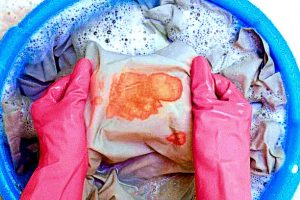 For some clothes, it is best to avoid the washing machine and take a hand-washing approach. While manual cleaning is typically reserved for delicate fabrics, it is an effective method to use for most types of clothing. That is, especially if you don’t have enough clothes for a full load.
For some clothes, it is best to avoid the washing machine and take a hand-washing approach. While manual cleaning is typically reserved for delicate fabrics, it is an effective method to use for most types of clothing. That is, especially if you don’t have enough clothes for a full load.
Before you begin, always check your garment’s care label. They will let you know about any special temperature or product requirements. If the label says dry-clean only, do not hand-wash that piece. If you are hesitant about it, you can drop some water on a hidden corner of the garment and blot it away. If no colour comes off, it may be safe to wash in the sink. Keep in mind that if you go against the care label instructions, you are taking a risk. You may actually damage your clothes permanently. And that does not only concern water spotting or loss of colour, you may cause damage to the lining, stitching, trimming or even shrink the particular piece of clothing.
We would like to share some simple steps that you can take when hand-washing your clothes. Those would work for wool, cotton or even silk.
How to hand-wash clothes?
Hand-washing clothes is the most gentle approach you can take. It allows you to treat your clothing with extreme levels of care during the entire cleaning process. To save time, you can wash similar clothing together. If you have garments of the same fabric type or similar colours, for example. Keep reading to find out how to properly wash clothes. We will also share extra tips for delicates like bras, underwear or others.
- Read the care label and determine the type of fabric you are working with. That information will help you choose the correct detergent to use for the particular piece. Any liquid detergent should be suitable for most types of clothing. For more delicate fabrics, you may need to use mild laundry detergent or one free of harsh ingredients.
- Treat stains, if necessary. Pre-treat heavier stains by rubbing stain remover or laundry detergent over the stain with your fingertips. Do not rub harshly.
- Fill the sink with water – lukewarm or warm (depending on the care label of your clothes). Wool, silk and bright colours are best washed in cold water. As the water is running, add the laundry detergent. Make sure it is completely dissolved in the water before you put the clothes in it. Place your garments in the water and fully immerse them. While they are soaking, gently squeeze the water through the clothes. If it changes colour, do not worry. This may simply be excess dye and not a cause for colour-loss.
- Rinse thoroughly. If you have a sprayer on your faucet, place more delicate clothing and rinse them well. Otherwise, fill the sink with clean water and immerse the clothes in it. Squeeze them out and repeat in order to rinse the soap out completely.
- Remove excess water. Wringing wet clothing may cause damage to it. Instead, lift the garment and squeeze out all the water that is left. Then, lay it down on an absorbent towel and roll them together until all excess water is absorbed. Treat your clothes gently.
- Lay items to dry. In order to prevent gentle fabrics or knits from stretching out of shape, lay them down in order to dry them. For bigger pieces, place a towel underneath, then flip when the front side is dry.
How to wash delicates like bras or underwear?
Throwing your bras in the washing machine may be an easy solution, however it may cause poking wires or other damage in no time. Washing your bras by hand is recommended and will keep them in good condition for much longer. However, washing them by hand is extremely easy so keep reading to find out how.
- Fill the sink with lukewarm water. Add a gentle detergent and mix it well in the water.
- Carefully place the bra in the water. Let it soak for 15 minutes. Gently work the solution in all nooks and crannies of the bra.
- Rinse thoroughly. Either place the bar under the faucet sprayer or fill the sink with clean water, dip and squeeze out the bra a few times until soap stops coming out.
- Gently squeeze, reshape and lay flat to dry.
You can use these steps for all underwear, sweaters and other garments. Make sure you use safe, non-toxic detergents in order to protect your clothes and your skin. Do take extra care when treating delicate or special needs fabrics. Always make sure everything is fully dry before putting it away. You will prevent mould and mildew from appearing on your clothes or in your closet.
Do not wring out your hand-washed clothes and do not put them in the dryer. You will prolong their lives by treating them nice and gently.
